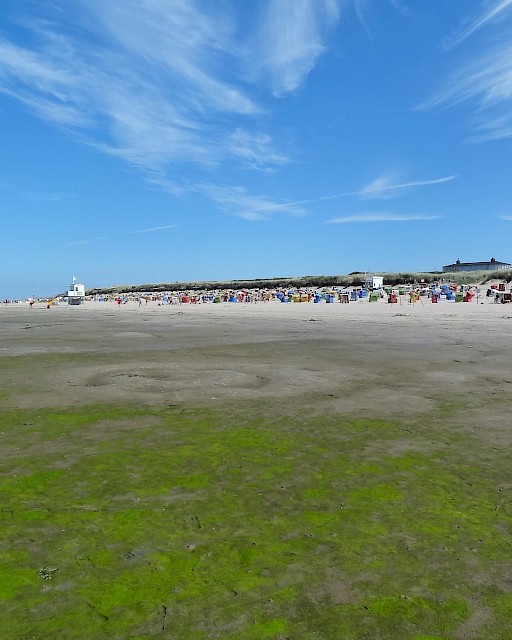Eutrophication
Eutrophication is the result of excessive enrichment of water with nutrients, which may accelerate the growth of algae (phytoplankton) in the water column. This may result in a range of undesirable disturbances in the marine ecosystem, including a shift in the composition of the flora and fauna, which in turn affects habitats and biodiversity, depletion of oxygen, changes in water clarity, and behavioural changes or even death of fish and other species.
Our latest assessments: Quality Status Report 2023
EUTROPHICATION THEMATIC ASSESSMENT
Briefing note on the thematic assessment
Concentrations of Chlorophyll-a in the Greater North Sea, Celtic Seas and Bay of Biscay and Iberian Coast: Since the Quality Status Report 2010 (QSR 2010) there have only been small changes in chlorophyll concentrations in the Greater North Sea (Region II), Celtic Seas (Region III) and Bay of Biscay and Iberian Coast (Region IV). Eleven assessment areas, all in OSPAR Region II show concentrations exceeding the threshold in the fourth application of the Common Procedure (COMP4) assessment period 2015 to 2020. This applies to 46% of the surface area of river plumes and 22% of the surface area of coastal areas (total surface area in Regions II, III, IV).
Concentrations of Dissolved Oxygen Near the Seafloor in the Greater North Sea, Celtic Seas and Bay of Biscay and Iberian Coast: In most areas assessed, concentrations of dissolved oxygen near the seafloor are above the threshold value of 6mg/l. However, oxygen depletion has been observed in the Eastern North Sea, Kattegat coastal and Kattegat Deep, though improvements in levels of dissolved oxygen concentrations have been observed in the Kattegat areas.
Winter Nutrient Concentrations in the Greater North Sea, Celtic Seas and Bay of Biscay and Iberian Coast: Since the Quality Status Report 2010 (QSR2010), winter concentrations of dissolved inorganic nitrogen (DIN) and phosphorus (DIP) have continued to decrease, mainly in coastal and some shelf areas in the Greater North Sea (Region II), Celtic Seas (Region III) and Bay of Biscay and Iberian Coast (Region IV). In the assessment period for the fourth application of the common procedure (COMP4) 2015-2020, 61% of the river plumes, 24% of coastal waters and less than 1% of shelf waters in the OSPAR area assessed (surface area km2) were not in good status for DIN. For DIP 38% of the river plumes and 11% of coastal waters were not in good status.
Human activities resulting in anthropogenic nutrient enrichment (nitrogen and phosphorus), encompass inputs from point sources (e.g. sewage plants or industry) and inputs from diffuse sources (e.g. agriculture, households not connected to sewerage, overflows, and atmospheric inputs).
The OSPAR Eutrophication Strategy sets the objective to combat eutrophication in the OSPAR maritime area, to achieve and maintain a healthy marine environment where anthropogenic eutrophication does not occur. The Strategy builds on long-standing commitments from Contracting Parties under OSPAR measures to achieve a substantial reduction at source in inputs of phosphorus and nitrogen into areas where these nutrients are likely to cause pollution. The eutrophication related work is implemented by OSPAR’s Hazardous Substances and Eutrophication Committee (HASEC).
OSPAR has developed a eutrophication assessment framework, "OSPAR Agreement 2022-07e Common Procedure for the Identification of the Eutrophication Status of the OSPAR Maritime Area” (the “Common Procedure”). Its purpose is to periodically assess the status of eutrophication and the progress being made towards the Strategy’s objective. The Common Procedure assists Contracting Parties to identify in a common, agreed and shared approach , areas where nutrient inputs may cause pollution.
OSPAR’s assessment work is supported by monitoring under the Eutrophication Monitoring Programme. This includes long-term data collection under the OSPAR monitoring programmes for:
- atmospheric inputs (Comprehensive Atmospheric Monitoring Programme – CAMP)
- riverine inputs and direct discharges (Comprehensive Study on Riverine Inputs and Directive Discharges – RID)
- concentrations and effects in the marine environment (Coordinated Environmental Monitoring programme – CEMP)
Monitoring is complemented by modelling activities on nutrient reduction scenarios and transboundary nutrient transport, to help direct future actions in combating eutrophication.
The implementation of the Eutrophication Strategy takes place within the framework of the obligations and commitments of Contracting Parties under other international agreements. This includes European Union legislation to reduce nutrient discharges and emissions, for example the Nitrates Directive (91/676/EEC), Urban Waste Water Treatment Directive (91/271/EEC), the Water Framework Directive (2000/60/EEC) and the Marine Strategy Framework Directive (2008/56/EC).
IA2017 Eutrophication status in areas assessed in Arctic Waters, the Greater North Sea, Celtic Seas, and the Bay of Biscay, 2006–2014:
Data available here: https://odims.ospar.org/maps/1052/view

